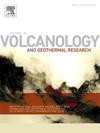Development of permeable networks by viscous-brittle deformation in a shallow rhyolite intrusion. Part 2: Microstructural analysis
IF 2.4
3区 地球科学
Q2 GEOSCIENCES, MULTIDISCIPLINARY
Journal of Volcanology and Geothermal Research
Pub Date : 2025-02-06
DOI:10.1016/j.jvolgeores.2025.108278
引用次数: 0
Abstract
Volcanic and magmatic outgassing mechanisms can determine eruptive behavior of shallow silicic magma bodies. Most outgassing mechanisms proposed take place along conduit margins, where the highest strain rates drive ascending magma to brittle failure. However, these mechanisms do not account for outgassing large volumes of magma away from the conduit walls. Here, we present a continuum of porosity preserved in the microcrystalline rhyolitic Sandfell laccolith, Eastern Iceland. Three stages in the continuum are described: porous flow bands, pore channels, and fracture bands. These deformation features are present throughout the entire exposed volume of the Sandfell laccolith in meter-long band geometries, ranging from mm- to dm-scale thickness, and interlayered with coherent, undeformed rhyolite. Using microstructural analytical methods and drawing on the result of previous experimental studies, we show that emplacement-related deformation induced strain partitioning around a crystal content of 45 % that resulted in the segregation of melt-rich and melt-poorer flow bands. Subsequent deformation induced by continued magma emplacement caused strain partitioning in the melt-rich flow bands. Depending on strain rate, different types of deformation features developed, through dilation or porosity redistribution (porous flow bands), cavitation (pore channels), or tensile fracture (fracture bands). Porous flow bands have permeability values ∼4 orders of magnitude higher than undeformed rhyolite. Pore channels and fracture bands have much larger length scales, and so permeability increases dramatically in those systems. Hence, the abundance and interconnectivity of deformation features preserved in the Sandfell laccolith provided an efficient outgassing mechanism for the bulk of the intrusion. Outgassing due to viscous-brittle magma deformation during magma emplacement should therefore be considered for crystal-rich magmas, e.g., during effusive lava dome extrusion.
浅层流纹岩侵入体粘脆变形形成渗透网络。第2部分:微观结构分析
火山和岩浆放气机制可以决定浅层硅质岩浆体的喷发行为。大多数提出的脱气机制都发生在管道边缘,在那里,最高的应变率驱使上升的岩浆脆性破坏。然而,这些机制并不能解释为何大量岩浆会从管道壁排出。在这里,我们展示了在冰岛东部的微晶流纹岩沙落岩中保存的连续孔隙度。描述了连续介质中的三个阶段:多孔流动带、孔隙通道和裂缝带。这些变形特征以米长的带状几何形式存在于整个沙落纹岩暴露体中,厚度从毫米到毫米不等,并与连贯的、未变形的流纹岩层间。利用显微组织分析方法和先前的实验研究结果,我们发现与就位相关的变形在晶体含量为45%时引起应变分配,导致富熔体和贫熔体流动带的偏析。岩浆持续侵位引起的后续变形导致了富熔体流动带的应变分配。根据应变速率的不同,形成了不同类型的变形特征,包括膨胀或孔隙度重新分布(多孔流带)、空化(孔隙通道)或拉伸断裂(断裂带)。多孔流纹岩的渗透率比未变形流纹岩高4个数量级。孔隙通道和裂缝带具有更大的长度尺度,因此在这些体系中渗透率显著增加。因此,沙丘泥质岩中保存的丰富且相互联系的变形特征为大部分侵入岩提供了有效的脱气机制。因此,在岩浆侵位过程中,由于黏性脆性岩浆变形而产生的放气应被考虑到富含晶体的岩浆中,例如,在喷涌熔岩穹丘挤压过程中。
本文章由计算机程序翻译,如有差异,请以英文原文为准。
求助全文
约1分钟内获得全文
求助全文
来源期刊
CiteScore
5.90
自引率
13.80%
发文量
183
审稿时长
19.7 weeks
期刊介绍:
An international research journal with focus on volcanic and geothermal processes and their impact on the environment and society.
Submission of papers covering the following aspects of volcanology and geothermal research are encouraged:
(1) Geological aspects of volcanic systems: volcano stratigraphy, structure and tectonic influence; eruptive history; evolution of volcanic landforms; eruption style and progress; dispersal patterns of lava and ash; analysis of real-time eruption observations.
(2) Geochemical and petrological aspects of volcanic rocks: magma genesis and evolution; crystallization; volatile compositions, solubility, and degassing; volcanic petrography and textural analysis.
(3) Hydrology, geochemistry and measurement of volcanic and hydrothermal fluids: volcanic gas emissions; fumaroles and springs; crater lakes; hydrothermal mineralization.
(4) Geophysical aspects of volcanic systems: physical properties of volcanic rocks and magmas; heat flow studies; volcano seismology, geodesy and remote sensing.
(5) Computational modeling and experimental simulation of magmatic and hydrothermal processes: eruption dynamics; magma transport and storage; plume dynamics and ash dispersal; lava flow dynamics; hydrothermal fluid flow; thermodynamics of aqueous fluids and melts.
(6) Volcano hazard and risk research: hazard zonation methodology, development of forecasting tools; assessment techniques for vulnerability and impact.

 求助内容:
求助内容: 应助结果提醒方式:
应助结果提醒方式:


